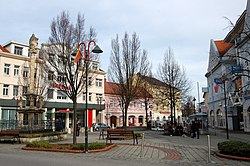Mattersburg
This article needs additional citations for verification. (March 2013) |
Mattersburg | ||
|---|---|---|
 Main square | ||
|
Postal code 7210 | ||
| Area code | 0 26 26 | |
| Vehicle registration | MA | |
| Website | www.mattersburg.gv.at | |
Mattersburg (German pronunciation:
Location
Mattersburg lies in the northern part of Burgenland, east of Wiener Neustadt in the Wulka River Valley, in a rural region of the country.
Mattersburg is reachable by road using the Burgenland Highway S31 from Eisenstadt and Oberpullendorf or the Mattersburg Highway S4 from Wiener Neustadt.
Mattersburg is connected by rail with Wiener Neustadt and Sopron by the Mattersburg Railway.
Mattersburg's two boroughs are Mattersburg and Walbersdorf.
History
The site of Mattersburg was already populated in antiquity based on excavations of
The area's original fortress had already been torn down by 1294. Mattersburg was elevated to the status of a market town in 1354. The town was destroyed by fire in the year 1774 and again in 1856. The area's wealth increased when the railway began running from Wiener Neustadt to Mattersburg in 1847. During the 19th century, the town was the site of a ceramics factory founded by János Ziegler in 1815 or 1818, producing yellow coloured wares following the style of Vienna porcelain.
The town was one of the Burgenland Siebengemeinden. The first Jews to settle in the town arrived in the 16th century, having been expelled from Sopron, and their presence in the town increased greatly over the following years. In 1671, the Jews were forced to abandon the town by the order of Leopold I. They were allowed to return to Mattersdorf, as it was then called, in 1678, although they were forced to buy back their own possessions. The self-governing Jewish community was merged with the rest of the town in 1902/03.
As with the rest of Burgenland, Mattersburg belonged to the
After the
Politics
The Mayor of Mattersburg is Ingrid Salamon of the Social Democratic Party (SPÖ); there are two Vice-Mayors: the first is Klaus Leitgeb of the Austrian People's Party (ÖVP) and the second Josef Reisner of the SPÖ. The District Mayor of the Borough of Walbersdorf is Hubert Lang of the SPÖ and Johann Wallner is the Chief Officer.
Mattersburg's municipal council has 25 seats with party mandates as follows: 9 ÖVP, 14 SPÖ, 1

Sport
Mattersburg was home to the former
Economy
One of the largest businesses in the area is the food company Felix Austria, who have their main headquarters in Mattersburg.
Notable residents
- Pál Kitaibel, born here
- Áron Chorin, born in Bohemia, studied here
- Akiva Eger(aka Akiva Güns), born in Eisenstadt, studied here
- Akiva Ehrenfeld, Orthodox rabbi, born here
- Shmuel Ehrenfeld, the Mattersdorfer Rav, born here
- Moses Sofer, born in Germany, was a rabbi here
- Simcha Bunim of Peshischa, born in Poland, studied here
- Jeremiah Mattersdorf, served as Chief Rabbi
See also
References
- ^ "Dauersiedlungsraum der Gemeinden Politischen Bezirke und Bundesländer - Gebietsstand 1.1.2018". Statistics Austria. Retrieved 10 March 2019.
- ^ "Einwohnerzahl 1.1.2018 nach Gemeinden mit Status, Gebietsstand 1.1.2018". Statistics Austria. Retrieved 9 March 2019.
External links
- (in German) SV Mattersburg Official Site
- (in German) SV Mattersburg Fan Portal
- (in English) Pictures and Information about Mattersburg
